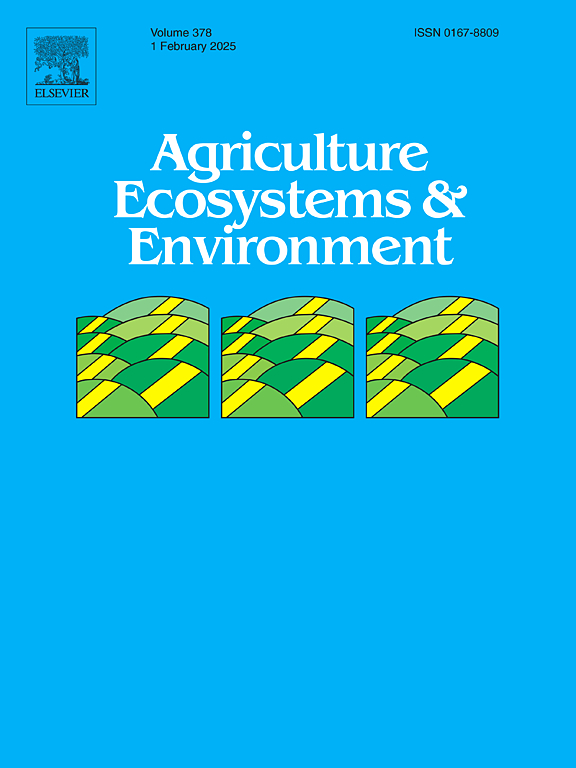Exogenous nitrogen enhances aboveground plant phosphorus accumulation through soil moisture and organic carbon in semi-arid grazed wetlands
IF 6
1区 农林科学
Q1 AGRICULTURE, MULTIDISCIPLINARY
引用次数: 0
Abstract
Agricultural utilization of wetlands has witnessed a continuous upward trend, with the semi-arid regions being especially prominent in this regard. These wetlands under human management have consequently emerged as crucial constituents within the agricultural ecosystem. Grazing is considered a predominant land use practice profoundly impacting nutrient cycling and redistribution in semi-arid wetlands, and exogenous nitrogen (N) from atmospheric deposition and agricultural water discharge simultaneously participated these processes. Nevertheless, the impacts of exogenous N input and grazing on phosphorus (P) distribution patterns remain nebulous, especially in the semi-arid Songnen Plain of China, where P limitation prevails. In order to address this knowledge gap, the study conducted a field experiment with four grazing intensities (natural, light, medium, and heavy) and two N addition levels (with and without) in semi-arid wetlands. The results show that grazing and N addition together affect P content in soil and plant organs. Grazing intensity generally reduces soil P, regardless of N addition, while N addition promotes soil P accumulation in natural wetlands. P content in plant organs increases with grazing intensity. Soil organic carbon (SOC), soil water content (SWC), electrical conductivity, and soil N are positively correlated with soil P but negatively correlated with P in stems and leaves. RDA shows that SWC and SOC are key factors influencing P distribution in soil and plant organs. Plant growth strategies create a positive correlation between root and soil P contents, and a negative correlation between P in stems, leaves, and soil. SEM further shows that grazing significantly affects P levels in soil and plant organs, while N addition boosts P uptake in roots and its transfer to aboveground organs, mediated by SWC and SOC. These findings show that exogenous N input alters P acquisition strategies and distribution in plant organs and soil in grazed wetlands of semi-arid regions. This study enhances understanding of P cycling and offers practical guidelines for sustainable wetland management.
外源氮通过土壤水分和有机碳促进半干旱放牧湿地地上部植物磷的积累
湿地农业利用呈持续上升趋势,以半干旱区最为突出。这些在人类管理下的湿地因此成为农业生态系统的重要组成部分。放牧被认为是影响半干旱湿地养分循环和再分配的主要土地利用方式,来自大气沉降和农业水排放的外源氮同时参与了这些过程。然而,外源氮输入和放牧对磷(P)分布格局的影响仍然很模糊,特别是在半干旱的中国松嫩平原,P限制普遍存在。为了解决这一知识缺口,本研究在半干旱湿地进行了4种放牧强度(自然、轻、中、重)和2种氮添加水平(加氮和不加氮)的野外试验。结果表明,放牧和施氮共同影响土壤和植物器官中磷含量。与施氮量无关,放牧强度总体上降低了土壤P,而施氮量促进了天然湿地土壤P的积累。植物各器官磷含量随放牧强度的增加而增加。土壤有机碳(SOC)、土壤含水量(SWC)、电导率和土壤氮与土壤磷呈显著正相关,与茎叶磷呈显著负相关。RDA表明,土壤碳和有机碳是影响土壤和植物器官磷分布的关键因素。植物生长策略导致根系与土壤P含量呈正相关,茎、叶和土壤P含量呈负相关。SEM进一步表明,放牧显著影响了土壤和植物各器官的磷水平,而施氮促进了根系对磷的吸收,并通过土壤碳和有机碳介导向地上器官转移。这些结果表明,外源氮输入改变了半干旱区放牧湿地植物器官和土壤中磷的获取策略和分布。本研究有助于加深对磷循环的认识,为湿地可持续管理提供实用指导。
本文章由计算机程序翻译,如有差异,请以英文原文为准。
求助全文
约1分钟内获得全文
求助全文
来源期刊

Agriculture, Ecosystems & Environment
环境科学-环境科学
CiteScore
11.70
自引率
9.10%
发文量
392
审稿时长
26 days
期刊介绍:
Agriculture, Ecosystems and Environment publishes scientific articles dealing with the interface between agroecosystems and the natural environment, specifically how agriculture influences the environment and how changes in that environment impact agroecosystems. Preference is given to papers from experimental and observational research at the field, system or landscape level, from studies that enhance our understanding of processes using data-based biophysical modelling, and papers that bridge scientific disciplines and integrate knowledge. All papers should be placed in an international or wide comparative context.
 求助内容:
求助内容: 应助结果提醒方式:
应助结果提醒方式:


